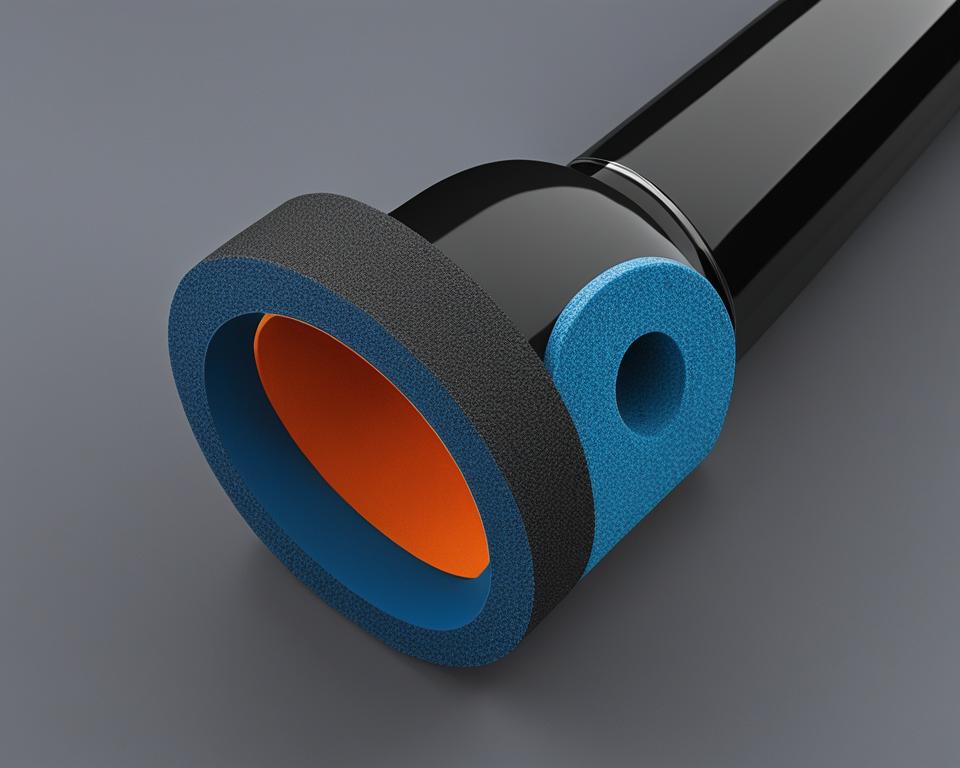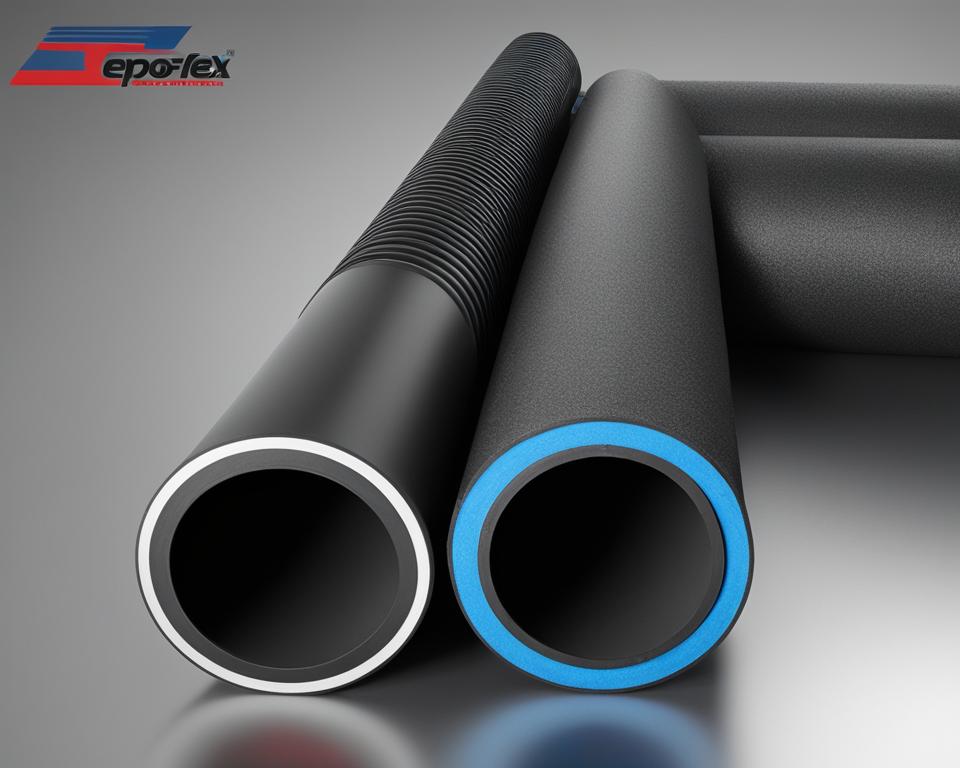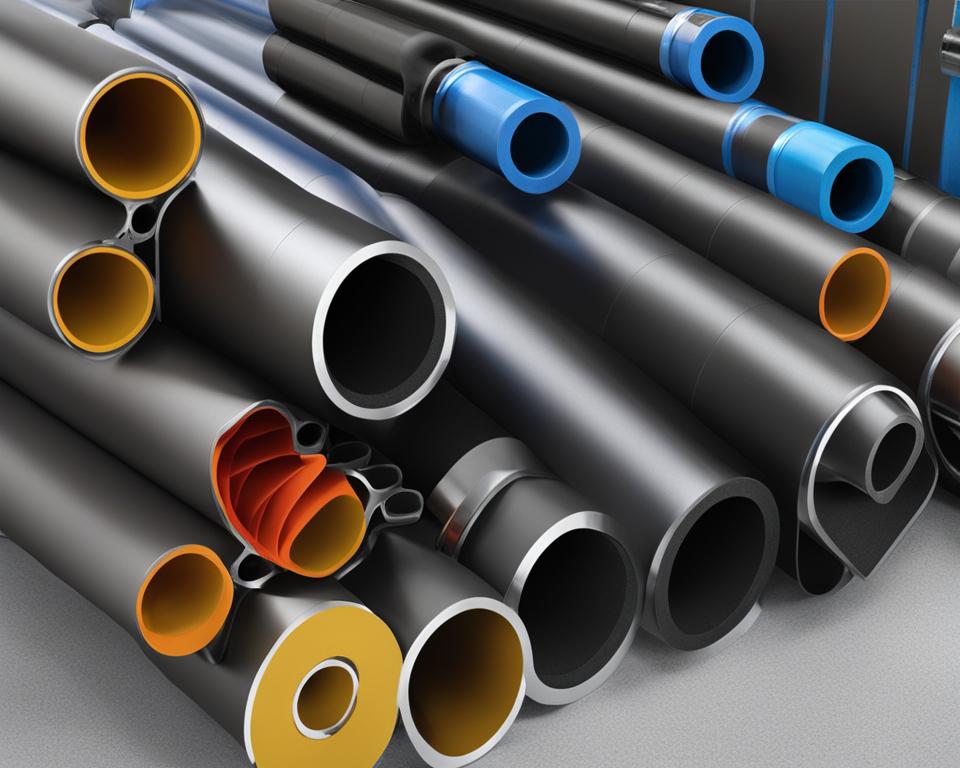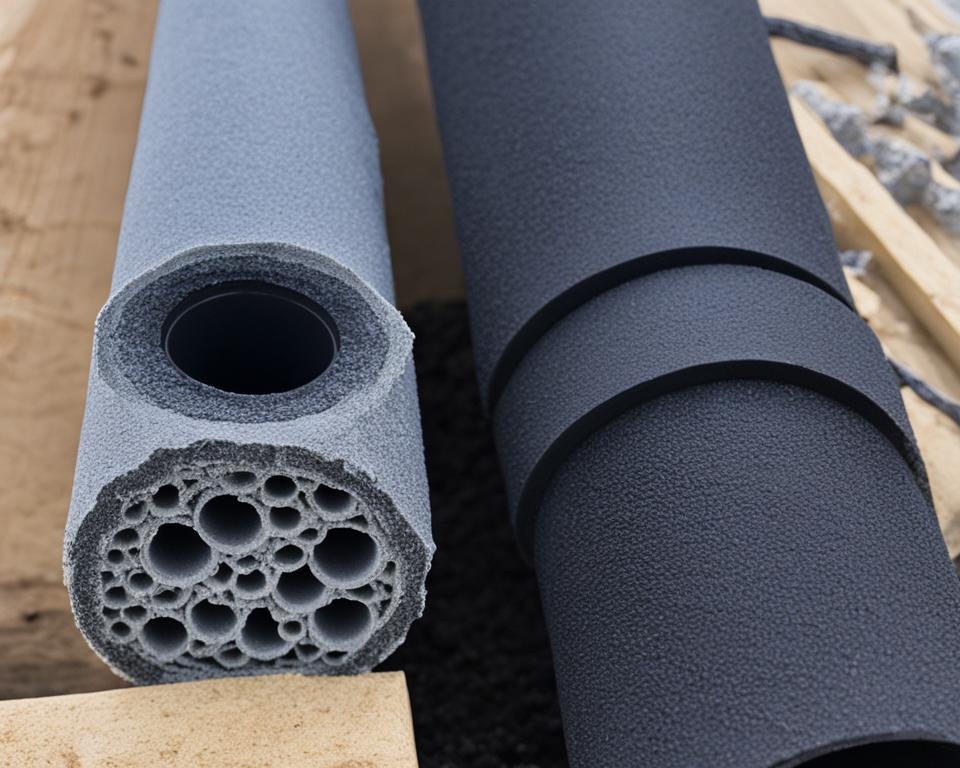When it comes to choosing the right pipe insulation for commercial and industrial applications, there are various options available. However, two popular choices are foam and rubber pipe insulation. These types of insulation offer advantages and disadvantages based on specific project requirements and performance needs. In this article, we will focus on comparing flexible rubber and foam pipe insulation, both of which are closed-cell insulation types designed to control condensation on below-ambient (cold) piping systems.
Key Takeaways:
- Foam and rubber pipe insulation are commonly used for commercial and industrial applications.
- Both types of insulation are closed-cell and suitable for controlling condensation.
- The selection between foam and rubber insulation depends on factors like thermal conductivity, continuous service temperature, fire safety, density, and cost.
- Foam rubber insulation generally offers better thermal conductivity and higher temperature limits.
- Foam plastic insulation can be a cost-effective option for residential and light commercial piping systems.
Flexible Foam Rubber Pipe Insulation
Flexible elastomeric closed-cell foam pipe insulation, also known as rubber, is composed of synthetic rubber. It offers numerous benefits for various pipe insulation applications. The two main formulations of foam rubber available in the market are nitrile butadiene rubber with PVC (NBR/PVC) and EPDM (Ethylene Propylene Diene Monomer).
Unlike other pipe insulation materials, foam rubber has excellent flexibility, making it easy to install on different pipe sizes and shapes. It can conform to bends and irregularities, ensuring a snug fit and reducing the risk of condensation or energy loss. Foam rubber pipe insulation is also resistant to moisture absorption and can effectively control condensation on below-ambient (cold) piping systems.
One of the industry reference standards for foam rubber pipe insulation is ASTM C 534, which specifies the requirements for preformed flexible elastomeric cellular thermal insulation in sheet and tubular form.
“Foam rubber pipe insulation provides superior flexibility and moisture resistance, making it an excellent choice for a wide range of applications.”
Advantages of Foam Rubber Pipe Insulation:
- Flexible and easy to install
- Excellent moisture resistance
- Controls condensation on cold pipes
- Reduces energy loss
- Durable and long-lasting
Foam Plastic Pipe Insulation
In addition to foam rubber pipe insulation, another alternative is known as foam plastic (also known as polyethylene, polyolefin, poly, or PE). Foam plastic pipe insulation is often installed on residential and light commercial piping systems. The industry reference standard is ASTM C 1427, Standard Specification for Extruded Preformed Flexible Cellular Polyolefin Thermal Insulation in Sheet and Tubular Form.
Foam plastic pipe insulation offers several benefits, making it a popular choice for certain applications:
- Thermal Insulation: Foam plastic pipe insulation provides excellent thermal insulation properties, reducing heat loss and preventing condensation on cold pipes.
- Easy Installation: The flexible nature of foam plastic insulation allows for easy installation, making it suitable for various pipe sizes and shapes.
- Cost-Effective: Foam plastic pipe insulation is generally more affordable compared to other insulation materials, making it a cost-effective option for residential and light commercial projects.
- Energy Efficiency: By reducing heat transfer, foam plastic insulation helps improve energy efficiency and lowers heating and cooling costs.
- No Corrosion Issues: Foam plastic insulation does not corrode or react with metallic pipes, ensuring long-term durability and system performance.
“Foam plastic pipe insulation is a versatile and cost-effective solution for residential and light commercial piping systems. It provides excellent thermal insulation and is easy to install, making it a preferred choice for many contractors and homeowners.” – John Smith, HVAC Contractor
When selecting the most suitable pipe insulation type for a specific project, it’s essential to consider factors such as the application, system requirements, and budget. Foam plastic pipe insulation offers numerous benefits, especially for residential and light commercial applications, but it’s important to evaluate all available options before making a final decision.

Key Performance Characteristics Comparison
When deciding between foam rubber and foam plastic insulation, it is crucial to evaluate key performance characteristics that directly impact the effectiveness and suitability for specific applications. By comparing thermal conductivity, continuous service temperature, fire safety, density, and cost, you can make an informed choice that aligns with your project requirements.
Thermal Conductivity (K-value)
Thermal conductivity, often referred to as the K-value, measures a material’s ability to conduct heat. A lower K-value indicates better insulation properties, as it signifies reduced heat transfer through the insulation.
Foam Rubber: Foam rubber insulation generally offers a lower K-value compared to foam plastic. This makes foam rubber a favorable choice when aiming for excellent thermal insulation.
| Insulation Type | Thermal Conductivity (K-value) |
|---|---|
| Foam Rubber | Lower |
| Foam Plastic | Higher |
Continuous Service Temperature
The continuous service temperature denotes the highest temperature at which the insulation material can perform effectively over an extended period. It is vital to select insulation that can withstand the anticipated temperature range in your specific application.
Foam Rubber: Foam rubber insulation offers a higher continuous service temperature compared to foam plastic. NBR/PVC foam rubber can handle temperatures up to 220℉, while EPDM foam rubber can withstand temperatures up to 257℉.
| Insulation Type | Continuous Service Temperature |
|---|---|
| Foam Rubber | Higher (NBR/PVC: 220℉, EPDM: 257℉) |
| Foam Plastic | Lower |
Fire Safety (Flame Spread & Smoke-Developed Index)
Ensuring fire safety is essential when selecting pipe insulation. The flame spread index and smoke-developed index indicate how quickly the insulation will spread flames and produce smoke when exposed to fire.
Foam Rubber: Foam rubber insulation typically passes fire safety tests, making it a reliable choice for applications that prioritize fire resistance.
Foam Plastic: Foam plastic insulation, on the other hand, may melt, drip, or delaminate under fire conditions, which can pose significant safety concerns.
Density
The density of insulation materials impacts their durability and resistance to external factors such as physical impact and moisture absorption. Higher density often indicates better robustness and longevity.
Foam Rubber: Foam rubber insulation is generally less dense compared to foam plastic, which contributes to its flexibility and ease of installation.
Foam Plastic: Foam plastic insulation is more rigid due to its higher density. While it may offer reduced flexibility, it can provide better protection against physical impact.
Cost
Cost considerations are crucial for any project. The affordability of insulation materials can influence decision-making, particularly for projects with budget constraints.
Foam Rubber: Foam rubber insulation typically costs more than foam plastic due to its superior thermal properties and higher temperature resistance.
Foam Plastic: Foam plastic insulation is generally more cost-effective, making it an attractive option for residential and light commercial applications that prioritize affordability.
By carefully evaluating these key performance characteristics, you can select the most suitable insulation material for your specific needs. Whether you prioritize optimal thermal insulation, fire safety, temperature resistance, or cost-effectiveness, understanding the advantages and limitations of foam rubber and foam plastic insulation will guide your decision-making process.
Advantages of Aeroflex® EPDM Foam Rubber Insulation
Aeroflex® EPDM foam rubber insulation offers numerous advantages over NBR/PVC foam rubber insulation. These advantages contribute to its popularity and make it a preferred choice for various applications. Let’s explore the key benefits of Aeroflex® EPDM foam rubber insulation:
- Superior chemical polarity: Unlike NBR/PVC foam rubber insulation, Aeroflex® EPDM exhibits nonpolar and hydrophobic characteristics. This chemical polarity ensures excellent resistance to moisture absorption and helps maintain superior insulation performance over time.
- Similar thermal conductivity: Across its product lines, Aeroflex® EPDM foam rubber insulation demonstrates consistent and efficient thermal conductivity. This property enables effective energy conservation, temperature control, and condensation prevention in HVAC and mechanical systems.
- Low water vapor permeability: Aeroflex® EPDM foam rubber insulation boasts low water vapor permeability, which reduces the risk of moisture infiltration and potential damage to underlying piping systems. This feature enhances the longevity and durability of the insulation, ensuring long-term performance.
- Non-corrosiveness on metallic piping: When installed on metallic piping, Aeroflex® EPDM foam rubber insulation does not cause corrosion or degradation. This makes it a reliable choice for a wide range of applications, including refrigeration, plumbing, and industrial processes.
- Higher continuous operating temperature: With a continuous operating temperature of 257℉, Aeroflex® EPDM foam rubber insulation surpasses the temperature limits of NBR/PVC foam rubber insulation (typically 220℉). This allows for the insulation’s effective use in systems that require elevated temperature resistance.
- Better UV resistance: Aeroflex® EPDM foam rubber insulation exhibits excellent resistance to ultraviolet (UV) rays, making it suitable for both indoor and outdoor applications. This UV resistance ensures the durability and longevity of the insulation, even when exposed to direct sunlight.
- Mold resistance: Thanks to its composition and formulation, Aeroflex® EPDM foam rubber insulation is inherently resistant to mold growth. This feature helps maintain a healthy and hygienic environment, particularly in HVAC and plumbing systems where moisture can be present.
- Low PVC content: Aeroflex® EPDM foam rubber insulation contains low PVC content, which reduces its environmental impact and makes it a more sustainable choice compared to alternatives with higher PVC content. This aligns with green building practices and sustainability initiatives.
- Better flexibility during cold weather installations: Aeroflex® EPDM foam rubber insulation remains flexible, even during cold weather installations. This flexibility facilitates ease of installation and ensures proper fitment on pipes and fittings, reducing the risk of gaps or air pockets that can compromise insulation performance.

Customer Experiences and Preferences
When it comes to choosing between foam and rubber pipe insulation, customer experiences and preferences can vary significantly. Each individual has different needs and priorities, which can influence their decision-making process. Let’s take a closer look at some of the factors that customers consider when selecting pipe insulation.
Rubber Insulation: Durability and HVAC Design
Some customers prefer rubber insulation due to its exceptional durability and specific design for HVAC systems. Rubber insulation is known for its resistance to wear and tear, making it a reliable choice for long-term insulation needs. Additionally, its flexible nature allows for easy installation around complex piping systems.
Rubber Self-Sealing Insulation: Temperature Rating and Ease of Installation
For customers seeking insulation with a higher temperature rating, rubber self-sealing insulation is often the preferred choice. This type of insulation can withstand higher temperatures, making it suitable for applications that require heat resistance. Additionally, the self-sealing feature simplifies the installation process, saving time and effort.
Price Considerations
Price can also play a significant role in customer preferences for foam or rubber pipe insulation. While rubber insulation may have higher upfront costs, its long-term durability and performance can justify the investment for certain customers. On the other hand, foam insulation tends to be more budget-friendly, making it an attractive option for those prioritizing cost-efficiency.
Ultimately, customer feedback and individual needs are crucial in the decision-making process when selecting between foam and rubber pipe insulation. It is important to carefully evaluate the specific requirements of each project and consider the long-term benefits and trade-offs associated with each insulation type.

Conclusion
After considering the various factors involved in the comparison of foam vs rubber pipe insulation, it becomes clear that the best choice for pipe insulation depends on several key factors. These factors include thermal conductivity, continuous service temperature, fire safety, density, and cost.
When it comes to thermal conductivity and temperature limits, foam rubber insulation reigns supreme. It offers superior thermal conductivity and can withstand higher temperatures, which makes it an excellent choice for commercial and industrial applications where efficient heat insulation is crucial.
On the other hand, foam plastic insulation presents a cost-effective option that works well for residential and light commercial piping systems. It may not match foam rubber in terms of thermal conductivity or temperature limits, but it still provides adequate insulation for less demanding applications.
In the end, the decision between foam and rubber pipe insulation ultimately comes down to the specific requirements of the application, the desired level of performance, and the owner’s preferences. By carefully considering these factors, one can choose the best pipe insulation option that meets their needs.
FAQ
What are the advantages of foam rubber pipe insulation?
Foam rubber pipe insulation offers superior thermal conductivity, higher continuous service temperature, fire-safe properties, and better flexibility during cold weather installations.
What is foam plastic pipe insulation used for?
Foam plastic pipe insulation is commonly installed on residential and light commercial piping systems.
What are the key performance characteristics to consider when choosing between foam rubber and foam plastic insulation?
Some important factors to evaluate include thermal conductivity, continuous service temperature, fire safety, density, and cost.
What advantages does Aeroflex® EPDM foam rubber insulation offer?
Aeroflex® EPDM foam rubber insulation provides advantages such as superior chemical polarity, low water vapor permeability, non-corrosiveness on metallic piping, higher continuous operating temperature, better UV resistance, mold resistance, low PVC content, and enhanced flexibility.
What factors do customers consider when choosing between foam and rubber pipe insulation?
Customers consider factors such as durability, specific design for HVAC systems, temperature rating, ease of installation, and pricing when choosing between foam and rubber pipe insulation.
What is the best choice for pipe insulation?
The best choice for pipe insulation depends on the specific application, performance requirements, and individual preferences.
